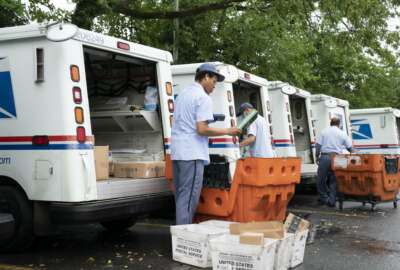

The Postal Service is pursuing a new service standard that would slow delivery of about a third of small, lightweight packages.
The Postal Service, in addition to pursuing service changes that would slow 40% of first-class mail, is pursuing a new service standard that would slow delivery of about a third of small, lightweight packages.
USPS executives told the Postal Regulatory Commission Monday that the proposed service change to its first-class package service (FCPS) — lightweight packages that weigh less than a pound — would cut costs by reducing the volume of packages that travel via contracted air delivery.
Businesses rely on first-class package service for items that include small electronics and prescription drugs.
Under the proposal, USPS would shift 32% of first-class package service volume from a three-day service standard to a four or five-day standard. About 64% of volume would not experience any change, while the remaining 4% of volume would see service upgraded from three-day to two-day service.
Much like its proposal to reduce first-class mail standards, USPS would seek to save money by moving away from air transportation, and would instead deliver more of its packages through its own ground transportation network.
USPS expects the proposed changes, if implemented, would save the agency at least $55 million annually, with the potential for additional cost savings in subsequent years.
“This would open up additional routing opportunities and opportunities for us to improve our service performance, as well as gain some transportation efficiencies,” Stephen Hagenstein, USPS director of logistics modeling and analytics, told the PRC on Monday.
USPS told its regulator that about 31% of first-class package service parcels are currently transported through air carriers. USPS delivered 1.8 billion parcels via first-class package service in fiscal 2020, a more than than 30% increase in volume compared to the year prior.
Thomas Foti, USPS vice president for product solutions, told the PRC that the agency would continue to show “modest growth over the coming years,” but nothing on par with the surge in packages driven by the COVID-19 pandemic last year.
“We don’t see the growth rates that we saw last year. In some instances we are seeing some declines,” Foti said.
Foti, in his written testimony to the PRC, said that these changes would allow the agency to improve overall on-time delivery and reliability, while also reducing costs.
USPS projects demand for first-class package service will remain high, based on a survey of more than 400 customers who rely on this service. Survey respondents said competitive pricing was their primary reason for using the service.
“There is no commercial service that can even come close to the price and efficiency of the U.S. Postal Service,” one customer wrote in a public comment to the PRC.
Other public comments, however, expressed concern over delays for essential goods like prescription drugs.
“Discontinuing the use of planes to move mail will delay delivery of prescription medications to citizens, especially seniors,” another commenter wrote.
Foti said businesses would mitigate the impact in service by moving to a more decentralized network of outposts to ship parcels to customers nationwide.
“You see more and more of that volume moving closer to the end consumer, moving shorter distances. The expectation is that is where the market goes,” Foti said.
Copyright © 2025 Federal News Network. All rights reserved. This website is not intended for users located within the European Economic Area.
Jory Heckman is a reporter at Federal News Network covering U.S. Postal Service, IRS, big data and technology issues.
Follow @jheckmanWFED


